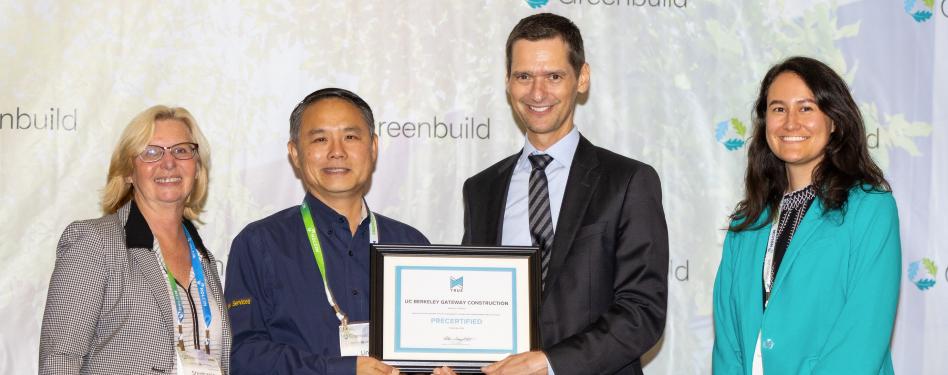
USGBC and GBCI President and CEO Peter Templeton presents The Gateway's TRUE for Construction Precertification certificate to Lin King, Cal Zero Waste Manager, at Greenbuild in Washington, D.C. Photo credit: Moshe Zusman for U.S. Green Building Council.
This month, the Gateway, a new academic building that is in construction on the north side of the University of California, Berkeley (UC Berkeley), campus, achieved precertification under the TRUE for Construction pilot, administered by GBCI. TRUE certification is a leadership standard that helps sites and organizations measure, improve and recognize zero waste performance through sustainable resource management and reduction practices.
Waste diversion
The Gateway is one of only a handful of projects to have earned the TRUE for Construction designation to date, and the project team worked closely with the university to ensure that the requirements—including regular waste auditing, a waste diversion rate of over 90% and an in-depth source-separation program—were met. “With construction and demolition (C&D) waste making up over a quarter of California’s landfills, it was important to the client and our team that we do our part to maximize our diversion as much as possible,” explained Emi LaFountain, sustainability integration manager for Turner Construction. “TRUE provides a great framework of best practices for us to be able to do just that.”
However, meeting such high diversion rates is no easy feat. As explained by Nelson Russom, waste and circularity program manager at Turner Construction, “TRUE requires that several waste streams, including incinerated biomass and alternative daily cover, count as waste in the calculations, which otherwise would be counted as diverted in California.” In order to meet the 90% diversion minimum, the project team set up the job to source-separate several standard materials, including concrete, steel and clean dirt, as well as some less common waste streams, such as municipal solid waste (or, in this case, worker waste).
Waste reduction
In addition, language was incorporated into scopes of work that emphasized waste reduction. For example, subcontractors were directed to avoid bringing in single-use plastic bottles on site, instead using the filtered water dispensers made available throughout the project. Permasteelisa, the curtain wall trade partner for the project, committed to delivering the glazing units and accessories in steel bunks and bins, respectively, which will be returned to the facility for reuse. The team is also drawing upon past project experience to try and maximize bulk orders of materials, such as joint compound and paint, in lieu of five-gallon buckets. “In our experience, diverting structural material like concrete and metal isn’t too difficult in the Bay Area,” explained Mayra Morales, project engineer for Turner. “It starts getting more challenging when you enter into the interiors phase—where there’s less of a demand for those waste streams—so not bringing it on site in the first place is a big priority for us.”
More information
“The success of any zero waste project comes from participation,” explained Stephanie Barger, director of market transformation for TRUE. “It’s on display in the Gateway construction project, as Turner Construction works closely with the hauler, Groundforce, the zero waste team at UC Berkeley, headed by Lin King, and the student zero waste lab. This collaboration has enabled the project to reach the high standards of TRUE precertification while providing 'real-world' educational experiences for our future leaders.”
The Gateway is anticipated to open during the 2025–2026 academic year and will be the new home of the College of Computing, Data Science, and Society—the first new college at UC Berkeley in 50 years.
